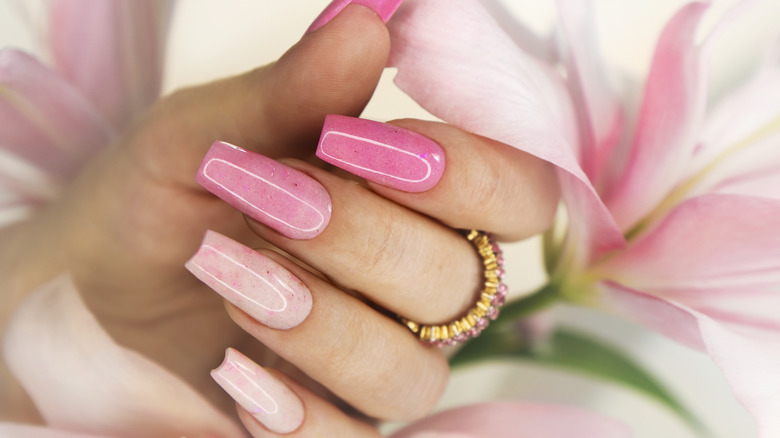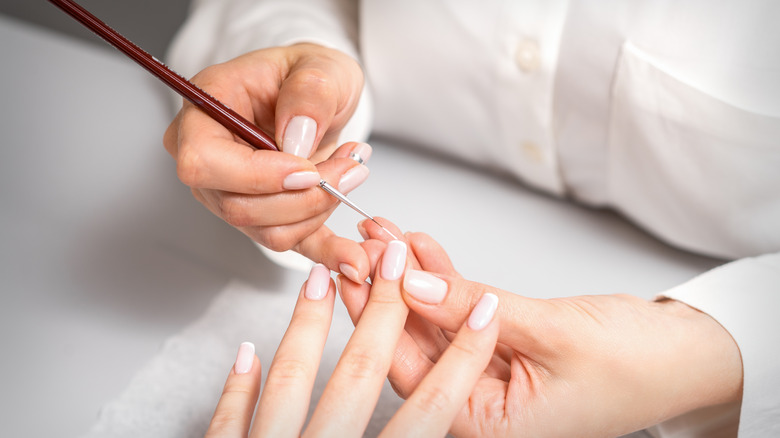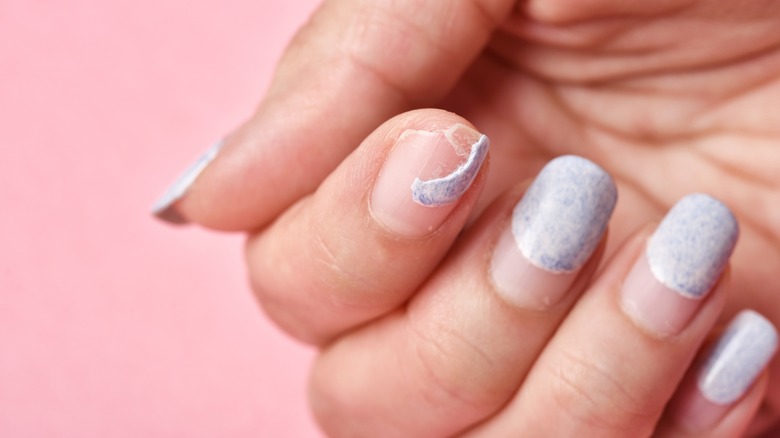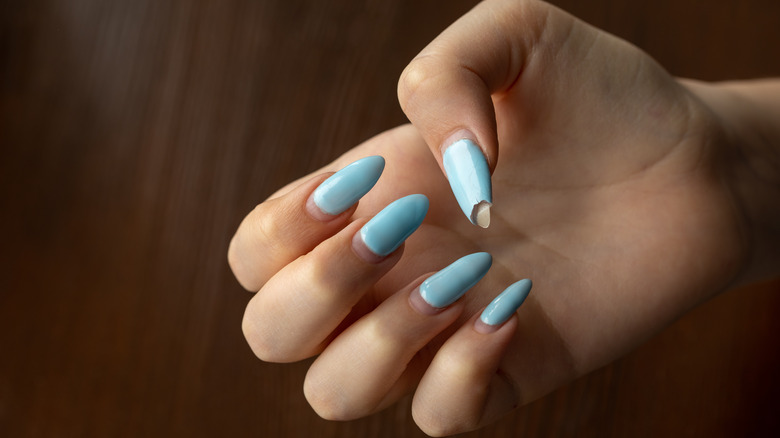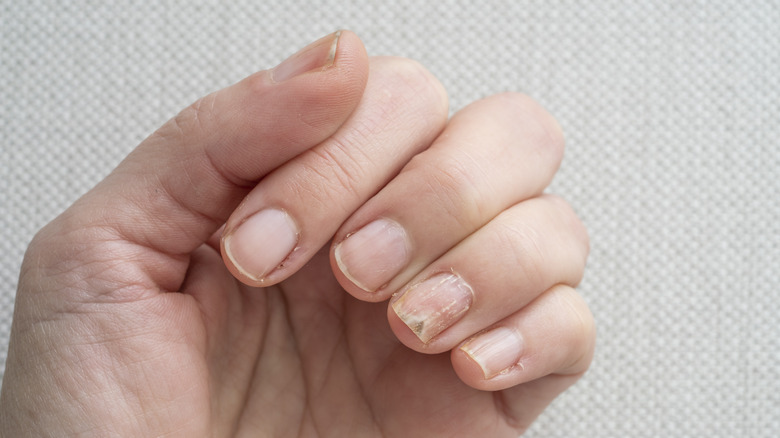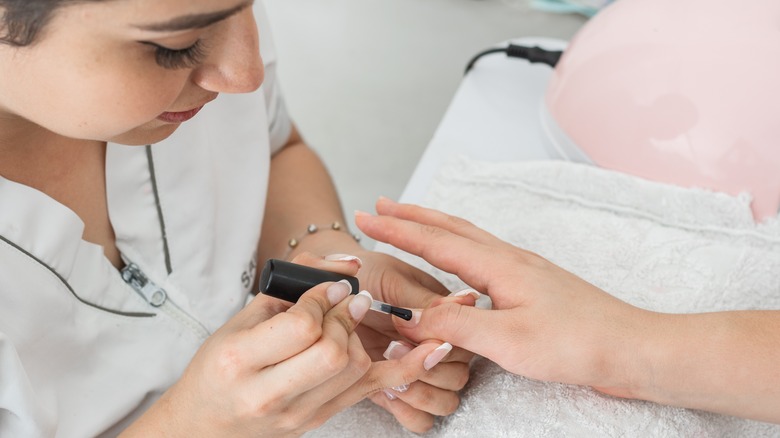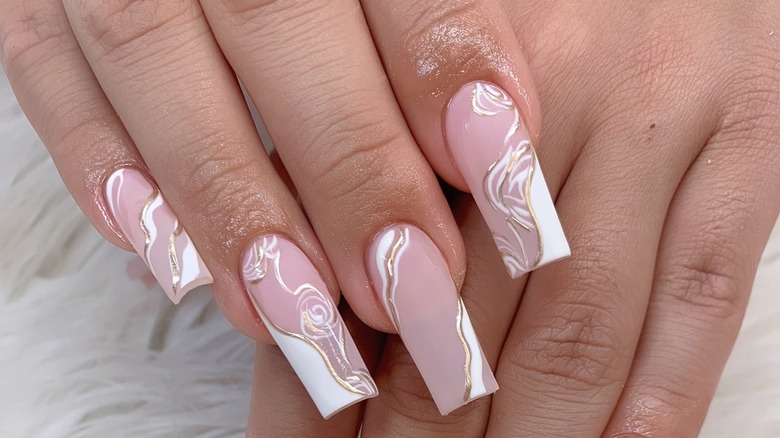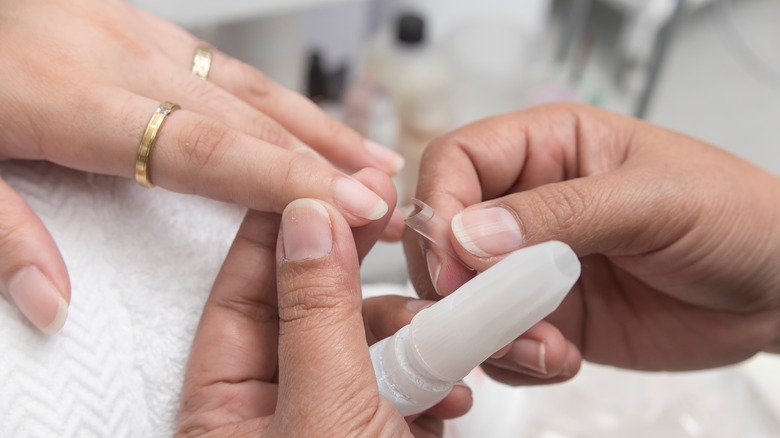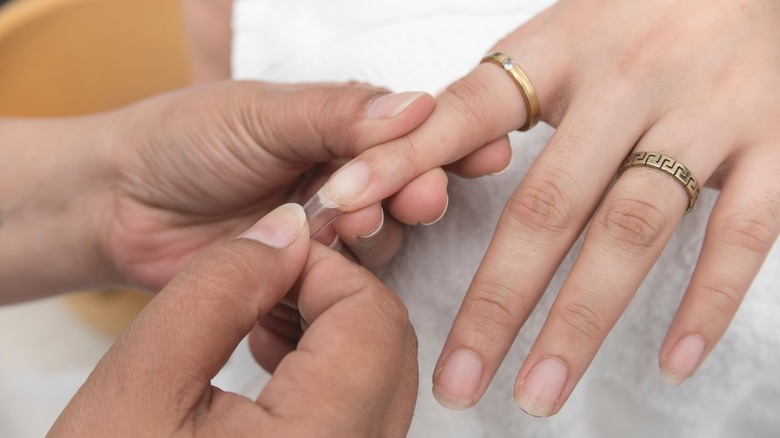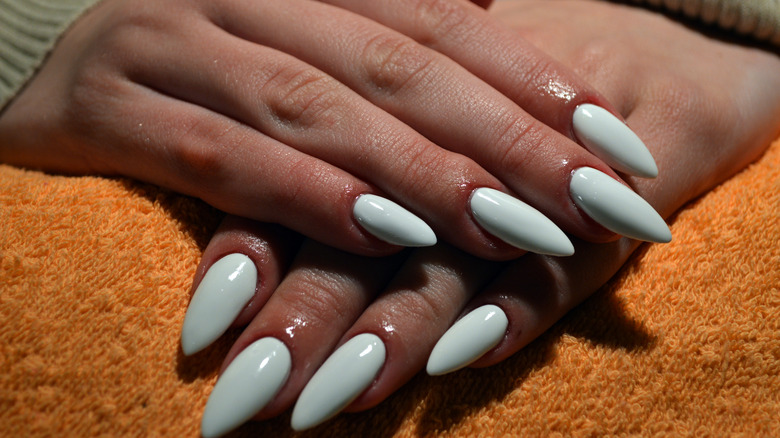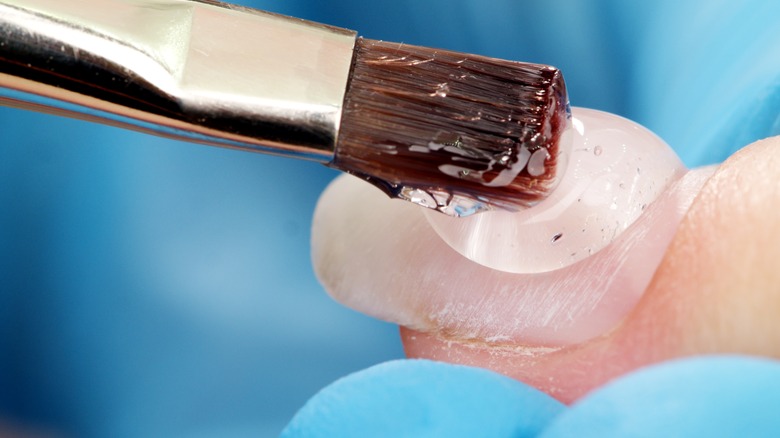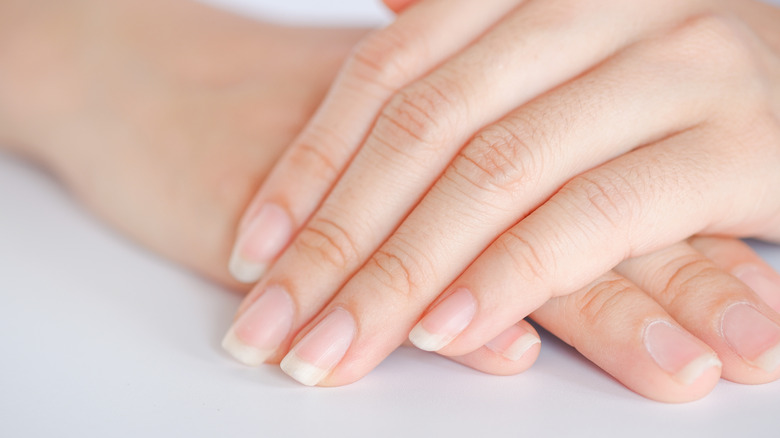What To Know Before Your Next Acrylic Nail Appointment
A cursory scroll through social media will show you influencer after influencer, adorned with the latest jewelry trends, showing off that "clean girl makeup" look, and finishing off their dazzling aura with a perfect manicure. Though nailing all these different elements of the trends popular today isn't easy, one of the more realistic self-care habits to add to your to-do list is getting a manicure. A quick 45 minutes in the salon usually does the trick for most of us, and in that time, our hands transform from those of a 12-year-old boy into the long talons of the professional millennial we are.
Everyone seems to have their own manicure preference. Some opt for the classic nail polish, though such an option tends to chip in just a couple days — especially for those who use their hands regularly. Others choose a gel nail look, using their natural nails for shape and length. Still, others see a manicure as an opportunity to take their hand look slightly further, choosing nail extensions to elevate their salon experience and the weeks to come. One of the most popular nail extension options is the acrylic nail, a technique that has been around for decades and is usually more affordable. Like any beauty treatment or experience, getting acrylic nails has pros and cons. So, before you dedicate an hour of your time and a chunk of change, here's everything you should know before making your next acrylic appointment.
First off, don't do acrylic nails at home
If you've ever found yourself wandering Target and happened upon the beauty section, you've likely seen at-home acrylic nail kits and supplies. Given that acrylics last a while, these at-home products can seem more enticing than press-on nails or nail polish. While you could take the plunge and opt for an acrylic manicure in your home, you should reconsider. Acrylic nails contain certain chemicals and require a steady hand as well as the ability to apply the jelly-like substance to the nails. Think about trying to do all of this using your non-dominant hand! With so much at stake and the inability to take off acrylic nails yourself without ruining your nail bed, you should leave it to professionals.
If you are determined to do your own acrylic manicure at home, you should know some tips and tricks. As noted by Byrdie, one of the most important elements is time. While a nail tech could do an acrylic set in a short period, you should give yourself at least an hour to do the job yourself. Next, you'll need an "all-inclusive kit" and will want to ensure that it doesn't come with methyl methacrylate mail tips — these tips are "tough, inflexible, and may cause an adverse reaction."
Once you have your kit chosen, make sure to follow the instructions — but if you want an acrylic set that looks great and takes half the time, leave it to the pros.
Acrylics can help thwart bad nail habits
You've opted to go to a nail salon. Not only will this option leave your nails looking long, manicured, and adorned with designs, but having such serious length and durability on your fingertips may stop you from biting your nails. Nail biting is a nasty habit that many of us have — it can feel nearly impossible to break at times. As noted by Byrdie, nail biting can be a sign of untreated anxiety or stress — oddly, biting your nail or the skin around the cuticle can be a source of relief. Still, such a habit can lead to some seriously raw skin, super short nails that can be painful, and in some cases, bleeding.
"It's a type of body-focused repetitive behavior," Dr. Sanam Hafeez explained. "There's a range of nail-biting. It can span from an occasional behavior to a self-mutilative behavior."
Still, for others biting their nails can be indicative of sucking their thumb as a child, Dr. Vivian Diller further explained. "Some women play with their hair for similar soothing results," Diller explained. And while biting your nails isn't the worst habit in the world, it can be difficult to break and result in some nasty nail results. Acrylics, meanwhile, can help break such a habit, given their thickness and strength. Plus, you likely won't want to mess up a manicure that looks so good! Why not give it a go?
If you have weak nails, there are pros and cons to acrylics
Some of you out there were blessed with amazing nails. Those not in this camp tend to follow a pattern. Our nails start growing; they get about a millimeter in length, and then they crack one by one. It's a sick twist of the universe, but acrylics pose a solution for those people. Acrylic nails are known for their durability and length. By getting acrylics done, those with inherently fragile nails can experience the long talons they so desperately want while also relying on the durability they are often known for. Sounds like a win-win, right? Hold your horses.
As noted by Salons Direct, even though getting acrylic nails done shouldn't damage your natural nail bed, the chances of damage are pretty high. Both the process of removing the acrylic nail and "poor application" can "seriously" impact the quality of your natural nails, which is bad for those with weak nails. Salons Direct further recommends who you go to when getting an acrylic set can make or break your nails, literally and figuratively. If the tech knows what they're doing and applies the substance correctly — and then you go back to have your acrylics removed — your nail beds should come out the other side relatively unharmed. Still, even the best application process can tire out weak nails. Salons Direct recommends taking a break from acrylics, even if you have "immaculately cared for nails."
If one of your acrylics breaks, you can likely get it repaired
Here's a real pro about getting an acrylic set — if one of your nails breaks, you can fix it. The bonus about this is that getting an acrylic nail fixed will likely only cost you a few bucks — in some cases, the nail tech might even do it for free.
Still, if you want to try to fix your acrylic nail and don't have the time to get out to the salon, More includes some helpful at-home tricks you need to know. If your acrylic breaks from the top, all you need to do is file it into a new shape. You might lose a little length, but it's better than nothing. If your acrylic nail is lifting — i.e., the base of the nail is starting to come up — the remedy process is a little more involved. You'll need nail glue — which can be found in the beauty aisle at any CVS or Target — and some rubbing alcohol. First step, you'll want to dip your entire finger in the rubbing alcohol to get rid of the natural oils on your nail and potentially in between the lifted acrylic and your nail bed. Once your nail has air dried, use the nail glue, dab a spot of it between the acrylic and your nail, and press down. Voila! A perfectly fixed acrylic nail at your kitchen table.
If your nail becomes damaged, get your acrylic removed immediately
When you break an acrylic nail, it seems as though there's nothing worse. It can look scraggly, far shorter than your other nails, and dull compared to its lacquered counterparts. But as it turns out, there is something much worse than a broken nail when it comes to acrylics, and it's important to know the signs if something serious has happened during your manicure. As noted by Well Kept Beauty, seriously damaging your acrylic nail — think getting your finger caught in the door, accidentally hitting it really badly, etc. — can cause a lot more harm than you might think. If pain radiates from your nail after such an accident, it's a good idea to remove your acrylic, as your natural nail may have split or gotten seriously bruised. Taking the acrylic set off will allow you to see what's going on.
Still, damage to your acrylic nails — and natural nails at that — can come from a nail tech themselves. Well Kept Beauty further points out that fungus, bacteria, and microorganisms can transfer from acrylic tools to your nails if they haven't been sterilized thoroughly, which can result in fungal infections or the loss of the nail completely. If you get an acrylic set done but start noticing redness, soreness to the touch, or substances in and around the nail, remove your acrylic nail immediately.
Nail techs can often apply acrylics with ease
One of the pros of getting acrylics done comes thanks to the technique's history. Other nail options — think gel, dip, GelX, etc. — are newer on the scene and don't have the decades-long history and experience that often comes with acrylics. As it turns out, the nail style was discovered accidentally in 1954. As noted by Cohen Cramer, dentist Frederick Slack was working in the office when he broke one of his nails. Using dental acrylics, he made a nail out of the substance, applied it to the broken area, and voila — one of the most sought-after beauty practices were created. Acrylics have since trickled into almost every nail salon and have been seen as both a fashion and beauty statement.
So what exactly is the substance in question? Cohen Cramer notes that Slack's concoction is a mix of liquid and acrylic powder, which is then applied to the nail bed — or, in many cases, to nail extensions — before it hardens. Once it's set, the nail can be filed into the desired shape, topped with the varnish of choice, and there you have it.
Given that acrylic nails have been around since the mid-1950s and have only gotten more popular with time — think of all those 1960s moms who had bright red acrylic nails, very in fashion at the time — nail techs typically know what they're doing when you request such a manicure.
Acrylics by definition look pretty fake
Now that you know the history of the acrylic nail and what the substance actually is, it's easier to wrap your head around the thickness and durability of the option. Initially intended for dentistry, the acrylic nail comes with a firm quality and hardness not easily replicated by other nail options. But with all those pros, acrylic nails have a drawback regarding their appearance: Acrylic nails look fake with a capital F.
In pop culture references from the 1950s, bright red nails filed to perfection were all the rage. Think of those old Coca-Cola ads and scenes from the beach, where the women looked perfect with their curled hair and perfect nails. While the look was replicated over and over, acrylics have a fake look to them that is pretty obvious. Their thickness, length, and even the sound they make when you rub them together scream artificial — fans of Dolly Parton must be thinking of her famous interview where she created a tune by gently hitting her acrylic nails together, singing a jingle as her nails made a "click click" sound that natural nails can't do (via YouTube).
"Acrylics are much stronger than gel which makes them more durable," Hannah Lee, a Sally Hansen nail expert, told Harper's Bazaar. "If you are looking to extend your nail quite a bit, then you would want acrylics, but if you're going for more of a natural look, gel is what you'd want."
Acrylics require monthly upkeep
All of us were going through our daily lives in March 2020 when the COVID-19 pandemic firmly took hold of the world. All of a sudden, life as we knew it came to a close, and regular habits like haircuts and nail appointments were tossed to the back burner. It was months before beauty businesses and salons reopened for clients, and then, capacity was incredibly limited. For many of us, getting our nails done and maintaining our manicures became the last thing on our list of priorities, and though the pandemic-era closures have ceased, it was an important lesson in what matters.
This was a deep way of saying that getting an acrylic set requires some serious upkeep. As noted by Cosmopolitan, acrylic nails can last several weeks, but your natural nail will continue to grow. If you go down this manicure route, you'll need to make going to the nail salon every couple weeks a habit.
"Your natural nails grow out regardless of how long your acrylics last, and you'll start to see growth at your cuticle beds after two weeks," Rita de Alencar Pinto, the founder of Vanity Projects nail salon, told Cosmopolitan. "A polish manicure will inevitably have more wear and tear—even on top of an acrylic base—so I suggest getting a gel manicure if you want your acrylics to last longer."
Acrylics are a more affordable option than others
While natural nails are the most affordable, many opt for a manicure to keep our nails looking fierce. There's something about having them done that makes so many of us feel like we have our lives together, but maintaining such a beauty routine comes with a price. A simple nail polish manicure on your natural nails will be the most affordable option, but if you want length and durability, an acrylic set is your best bet. Because acrylics have been around for so long, their price tag has gone down over the years. You can usually score a full acrylic manicure for about $35 to $45, depending on where you go, which is pretty fair given the time and skill involved in applying the nail extensions and the acrylic product. And, given that there are new nail trends firmly taking hold, acrylics aren't as sought after as they once were, making it easier to charge less than say a gel manicure or a dip set.
According to nail artist Brittney Boyce, the biggest difference between gel extensions and acrylic nails boils down to the chemical process and how each manicure type is removed. Telling Allure that this can impact the price tag, nail artist Shirley Cheng further explained that a gel extension set's more natural finish also increases the cost as opposed to acrylics.
Acrylics tend to last longer than dip nail polish
As you can tell from this extensive list, there are some pros and cons to getting acrylics. They can stop you from biting your nails, are more affordable than other nail extension options, and make a fun Dolly Parton approved clicking sound. Cons, of course, come at the potential cost of your own natural nails, regular upkeep, and accrued cost. But if you're dead set on getting a regular manicure and keeping it up, acrylics are the way to go when shelf life is taken into consideration. Compared to a dip set, acrylics tend to last quite a bit longer, and it all comes down to how the powder is structured. As noted by Vox, gel and acrylic substances are made up of "cross-link" polymers, whereas dip powder polymers don't connect with each other at all — all of this impacts just how long your nails will last.
"Gels and [liquid and powder acrylics] build net-like structures that are much more durable and stronger," Doug Schoon, a scientist who lends his skills to the beauty industry, explained. His sentiment was echoed by nail tech Robyn Schwartz, who explained, "Acrylic is liquid and powder, gel is gel. Period. If your nail tech can't tell you exactly what the product is called, if it comes out of a labeled mystery pot, or [they] insist it's gel even though it's powder, you're probably sitting in the wrong chair."
Double check to see if you're allergic to acrylic nail substances
After this list, you could be sold on getting acrylics, you could be questioning your manicure decision — either way, you have to make sure that you aren't allergic to the substances used in the acrylic process before you head to the salon. Just watching the process — even if you're not entirely sure what's being done, what's being dipped in what — proves that the acrylic manicure is a chemical process. Weighing in on the situation and just what can happen if you're allergic to the chemicals used are dermatologist Hadley King and nail tech Deborah Lippmann, who both told Byrdie that skin irritation, allergic reactions, thin nails, and dehydrated fingers are just some of the signs you should look for if you've had an allergic reaction to your acrylic set.
The chemical that seems to be the most negatively reacted to is methacrylate. A narrow — but notable — percentage of clients have had an allergic reaction to the chemical, with their skin around the nails flaring up as a result. The chemicals used in the acrylic process can also cause contact dermatitis, King told Byrdie, noting that cutting the cuticle can increase the risk of dermatitis.
"Don't trim the cuticles," King warned. "Cuticles protect the nail and surrounding skin from infections."
Give your nails some time off
We're not sure if we've sold you on acrylics or have made you think twice, but either way, you'll be heading into your next appointment armed with all the information you need to know about the manicure style. And while acrylics may seem like a great idea — especially in any scenario where you need your nails looking their best — it's also a good idea to give your nail beds a break after a while. As noted by Clutch Nails, you shouldn't go that long having acrylic set after acrylic set maintained on your nails, as your natural nails can take a hit. In fact, some nail experts recommend giving your nail beds as much as three to six months off in between regular sets, allowing your nails to grow, build back any thickness that has been lost thanks to acrylics, and breathe — acrylics are a lot of chemicals to have sitting on your nails for an extended period.
If you just have to have some sort of manicure done but are giving your nails a break from acrylics, why not opt for a nail-growing polish? Focus on taking supplements specifically for your hair, skin, and nails — these practices will help greatly with your next nail appointment, it turns out. "The healthier your nails, the longer your acrylics will last," Clutch Nails points out, so use the time in between your acrylic sets to focus on your nail health!
